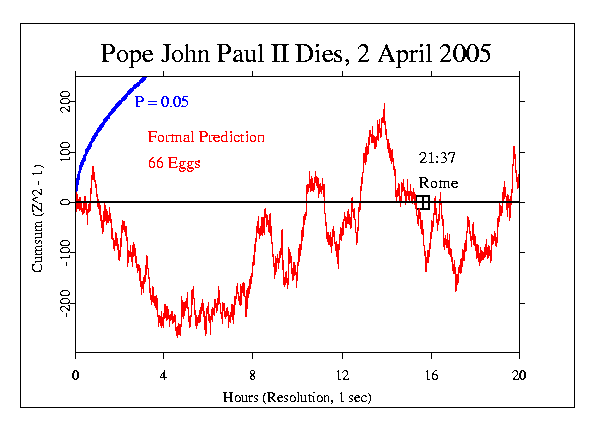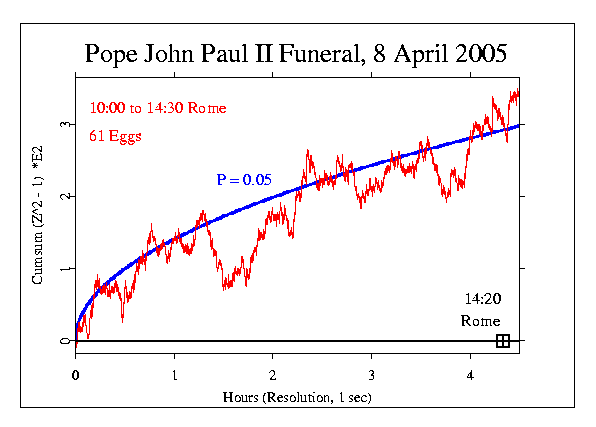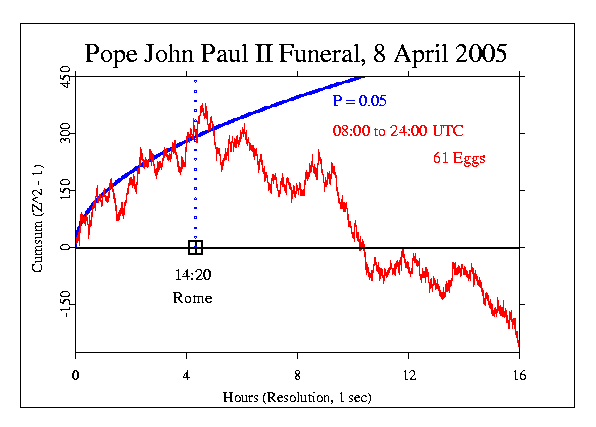|
From CNN.com:
VATICAN CITY (CNN) -- Pope John Paul II was remembered Saturday as a
"champion of human freedom," a "tireless advocate of peace" and a man
with a "wonderful sense of humor" who was easy to talk to.
The charismatic pontiff, who led the world's 1 billion Catholics for 26
years, died at 9:37 p.m. Saturday (2:37 p.m. ET) in his private
apartment, the Vatican said. He was 84.
"The Holy Father's final hours were marked by the uninterrupted prayer
of all those who were assisting him in his pious death and by the choral
participation in prayer of the thousands of faithful who for many hours
had been gathered in Saint Peter's Square," a Vatican statement said.
Archbishop Stanislow Dziwisz presided over a Mass for the pontiff in his
final hours.
"During the course of the Mass that the viaticum (communion for the
dying) was administered to the Holy Father and, once again, the
sacrament of anointing the sick," the statement said.
Archbishop Leonardo Sandri asked for a few moments of silence as he
announced the death to the thousands of faithful who had congregated in
St. Peter's Square. People in the crowd bowed their heads to pray, some
of them in tears.
Then they burst into applause.
"Let perpetual light shine on him, and let him repose in peace," Sandri
said.
The GCP's formal hypothesis test was set by consensus during a small
working meeting of analysts and physicists discussing research findings
and plans for the next years of the GCP. Usually, I make a prediction to
test, but the coincidence of our meeting and this global event lent
itself to a group decision. We decided that the time leading up to the
Pope's death was important because of the widespread attention.
The formal specification thus begins early in the morning in Europe, and
includes several hours after John Paul's passing. The formal data
segment is from 04:00 to 24:00 UTC on 2 April, which is 6am to 2am in
Rome.
The graph looks interesting, although the formal hypothesis test is not
impressive. The Z-score is 0.123, corresponding to a p-value of 0.451.

I had also made a prediction before deciding to use the group procedure.
It was a shorter period, specified as 1 hour before to 4 hours after the
Pope's death, which was at 9:37 pm in Rome. Here you can see the details
of the excursions of the data around the critical moment. Again, the
graph is interesting and somewhat unusual in the sharpness of the
oscillating trends. But the statistical evaluation, which addresses the
terminal point of the cumulative deviation, shows no departure from
expectation (indeed the final Z-score is 0.003, about as close to zero as
one can get).

The Funeral of Pope John Paul II
From the Washington Post:
VATICAN CITY, April 8 -- Before they carried Pope John Paul II through
the Door of the Dead to his burial place in St. Peter's Basilica, the 12
Vatican pallbearers slowly turned his cypress coffin so he would face
his flock one last time.
The 300,000 or more mourners on St. Peter's Square on Friday morning --
a kneeling, standing, tearful and radiant throng of Croatian students,
Filipina nuns, American teenagers and other pilgrims from countless
countries -- momentarily froze. Then came the cries from throughout the
crowd: Giovanni Paolo! Santo Subito! John Paul! Sainthood at once!
In
the stillness within St. Peter's, beyond the reach of television cameras
and away from the cacophony on the square, scores of scarlet-robed
cardinals formed an honor guard, lining both sides of the aisle leading
to the entrance to the crypt. A handful of the pope's closest colleagues
accompanied the coffin. The rest of the cardinals doffed their
zucchetti, or skullcaps, in tribute.
"It was total silence," said Cardinal Roger Mahony of Los Angeles.
"After the Holy Father had passed by and everybody left and were out of
sight, we turned to go back and take off our vestments, and no one said
a word. Not a word."
So went the last minutes of John Paul's funeral Friday: sadness and
anticipation, silence and cheers. John Paul, the pontiff who became a
global phenomenon, received a hero's send-off from the healthy and the
lame, the privileged and the poor before being lowered privately into a
simple grave beneath the basilica.
Even after his coffin had disappeared, the crowd was unwilling to let
go: The mourners remained outside and applauded for 10 minutes. The
knell of the basilica's 10-ton bell was followed by chimes from steeples
throughout Rome. Hundreds of thousands of other mourners watched the
funeral Mass on television screens at parks, plazas and fields in and
around the city. Millions more watched from around the world.
The funeral was scheduled to begin at 10:00 and the burial
was at 2:20 pm Rome time. Our formal hypothesis test specified the
period from 10 to 2:30 (08:00 to 12:30 UTC).
The trend is steady and statistically significant, with Z=1.966 and
p=0.024.

Context is provided in the next
figure, which shows the rest of the UTC day, comprising some 12 hours
following the funeral. The shape of the curve is striking, with the
positive trend until the formal ceremony ends, followed by a steady
low-going trend of the same slope.

Independent Predictions
Adrian Patrut sent a detailed description of events surrounding the
Pope's death. An exploratory assessment can add to our ability to
interpret the data over this period.
He also sent information on the election and investiture of the New
Pope, Benedictus XVI. See Further
Explorations for results and discussion.
| 


